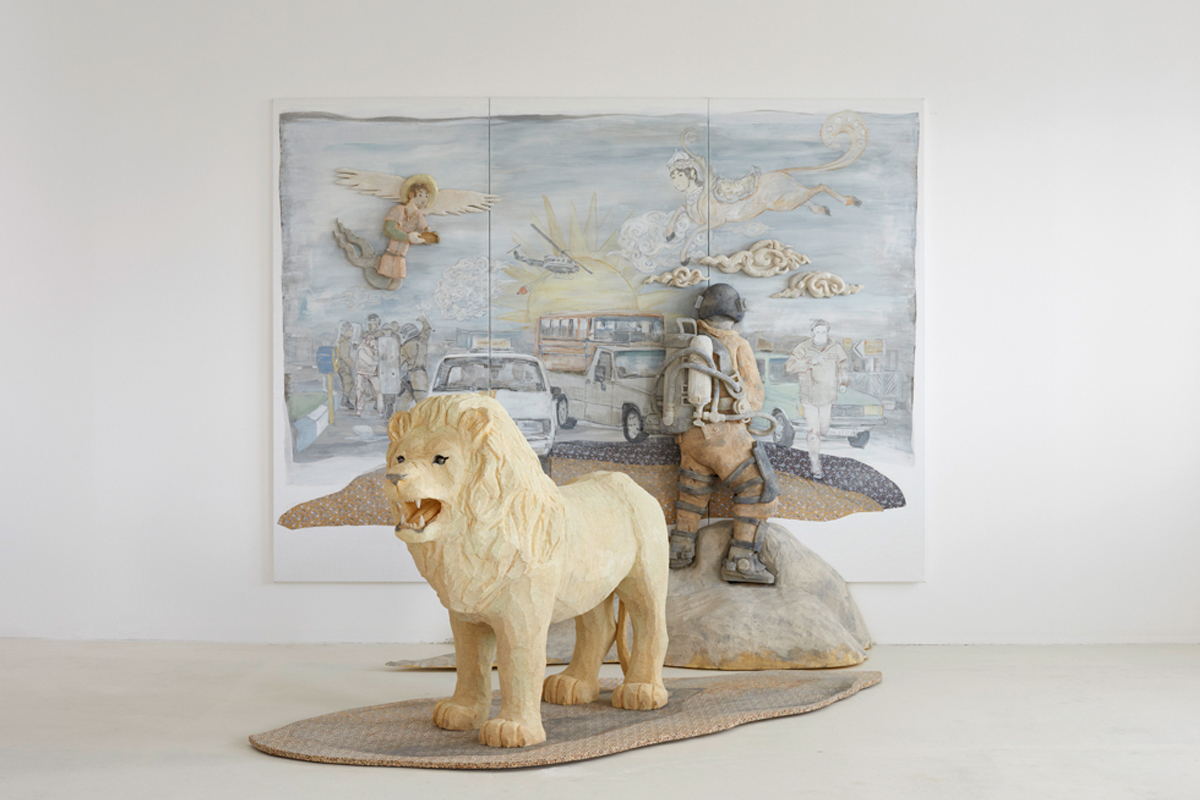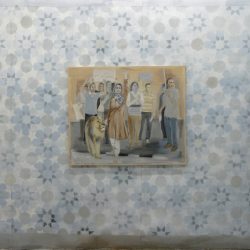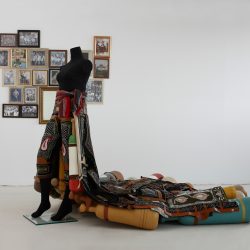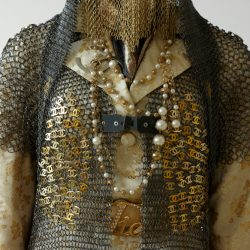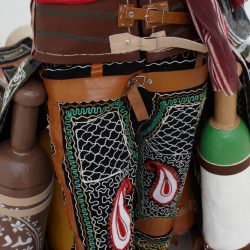NOW BASED IN BERLIN, HAKIMI-SCHÜLER CREATES ART THAT TALKS ABOUT HER CHILDHOOD MEMORIES THAT SAW BOTH THE ISLAMIC REVOLUTION AND THE IRAN-IRAQ WAR
Mona Hakimi-Schüler was born in 1977, two years prior to Iran’s Islamic Revolution. With her bachelor’s degree in engineering from a university in Tehran, she pursued her interest in art in Germany before earning a master’s from the University of Osnabrück in 2006. Hakimi-Schüler is currently working as an independent artist in Berlin where she shares a studio with other fellow artists and has continually produced a good number of both group and solo exhibitions over the past several years.

Photo by Michael Klaus, Image courtesy of Mona Hakimi-Schüler
She didn’t tell us specifically about her decision to move from Iran to Germany, but despite being in a different geographical and socio-political territory, the subject matter and style of her works revolve around Iran and her childhood memories that saw both the Islamic Revolution and the eight years of the Iraq-Iran War. These memories became the raw materials of several of her works such as Self-portraits (2007), a series of 12 paintings that express the extreme contradictions of female attire, from the simple traditional hijab to the fashionable pairing of the cloth with pink sunglasses or a spaghetti strap dress. For this particular series, the artist discusses the struggle in Iranian society to adjust to western culture with clothes being used as the medium. For Hakimi-Schüler, a change of clothes not only depicts the change of visuals caused by the constantly evolving trends but is also directly involved with the identity and ‘role’ of the women wearing them, with an interesting question being directed to her viewers, ‘among the 12 identities, which one is the real us?’
A CHANGE OF CLOTHES NOT ONLY DEPICTS THE CHANGE OF VISUALS CAUSED BY THE CONSTANTLY EVOLVING TRENDS BUT IS ALSO DIRECTLY INVOLVED WITH THE IDENTITY AND ‘ROLE’ OF THE WOMEN WEARING THEM
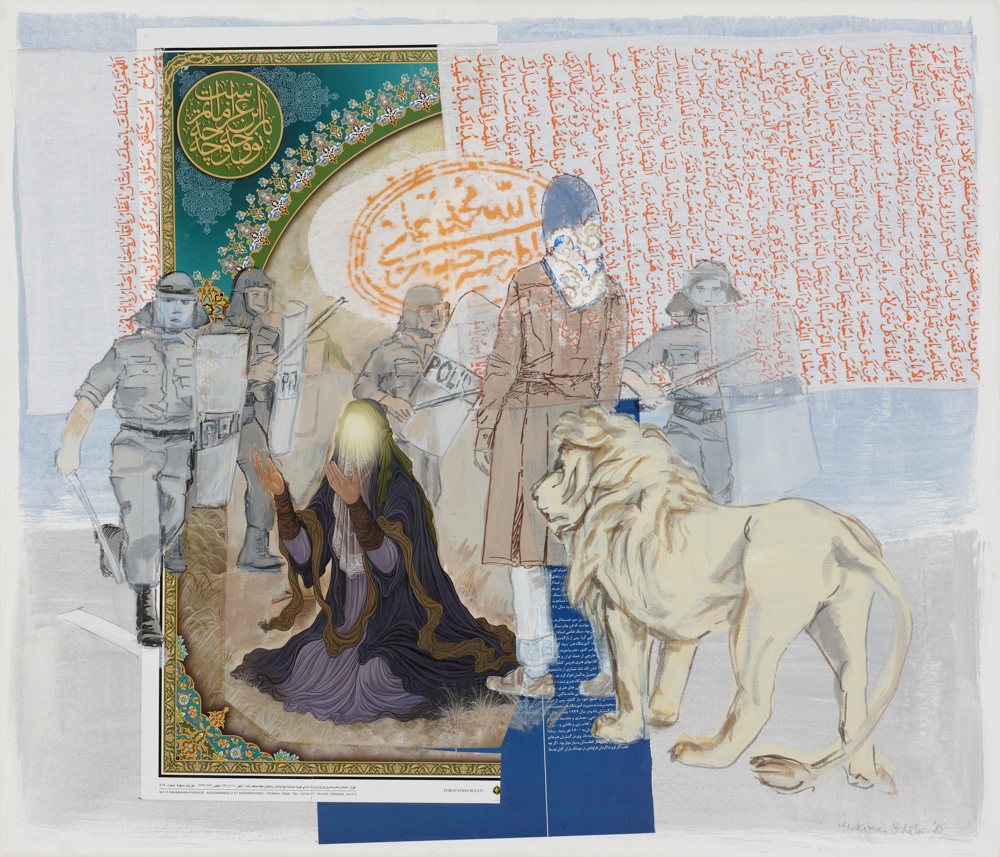
Photo by Michael Klaus, Image courtesy of Mona Hakimi-Schüler
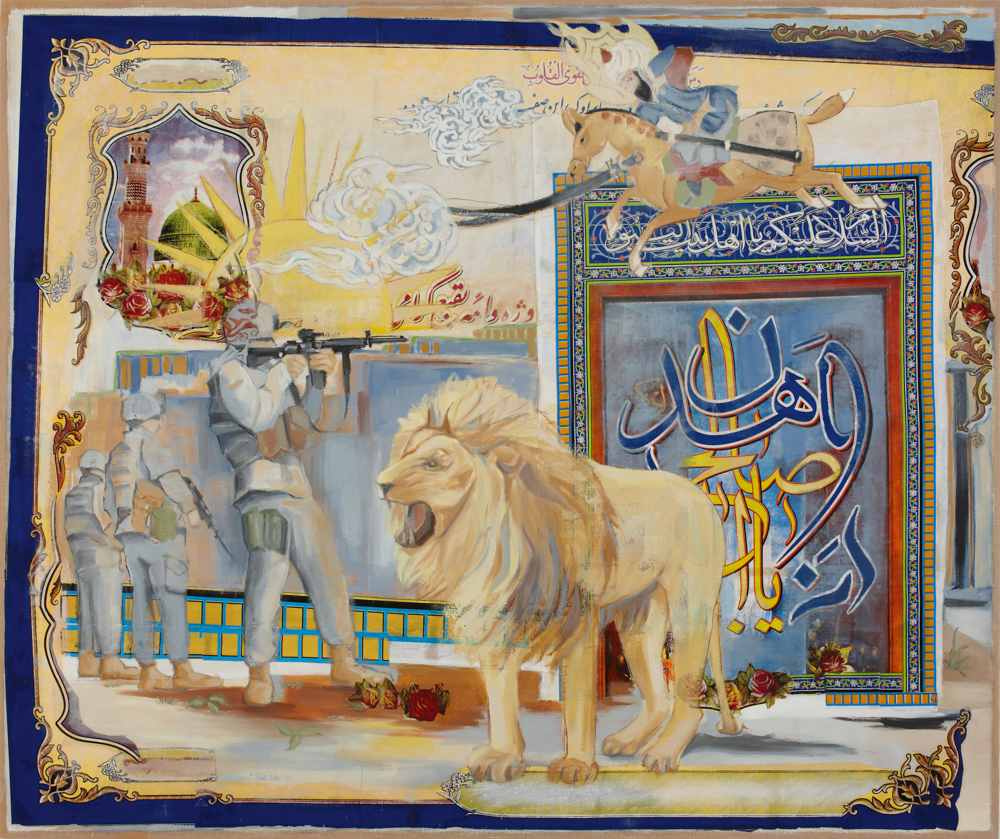
Photo by Michael Klaus, Image courtesy of Mona Hakimi-Schüler
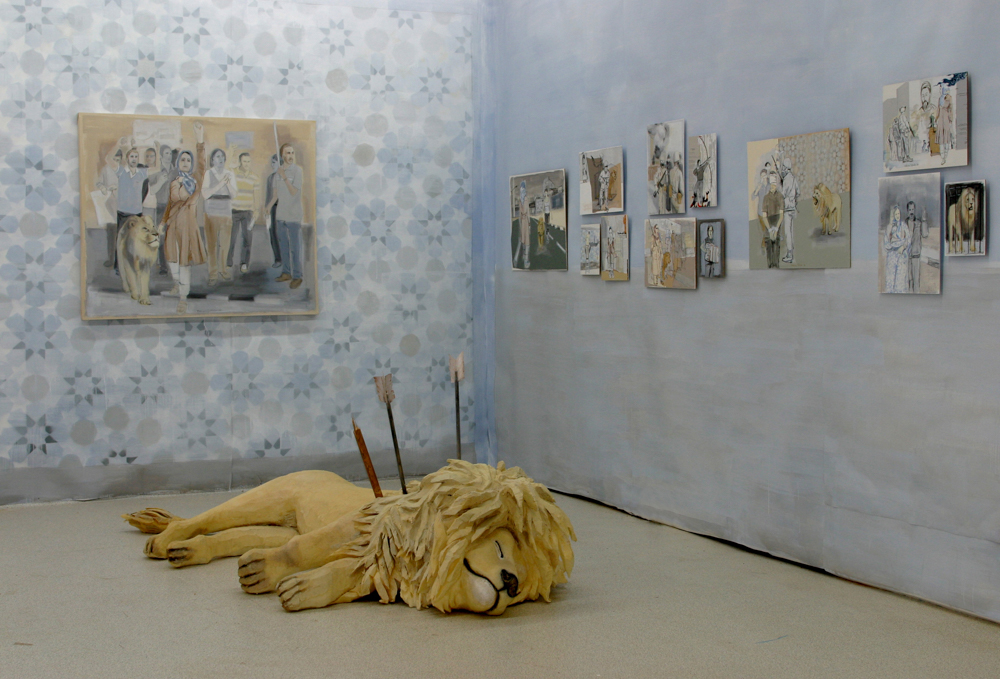
Photo by Michael Klaus, Image courtesy of Mona Hakimi-Schüler
Her installation pieces are equally interesting. With Helden-taten (2009- 2010) and Dreaming the past (2012- 2013), the artist uses the walls of the exhibition room as the background for her sculptures installed nearby, creating both a physical setting and context to serve the presence of each of the principal characters of her show. The relationship between the paintings on the wall and the sculptures becomes the most obvious in Head in clouds (2014-2015). The work grants two different but ambiguously related visual experiences, one being the sculpture that appears to be walking into the set on the wall and the other being the way the painting itself gradually extends from the plane of the wall, creating the final outcome of a lion sculpture walking toward the viewers.

Photo by Michael Klaus, Image courtesy of Mona Hakimi-Schüler
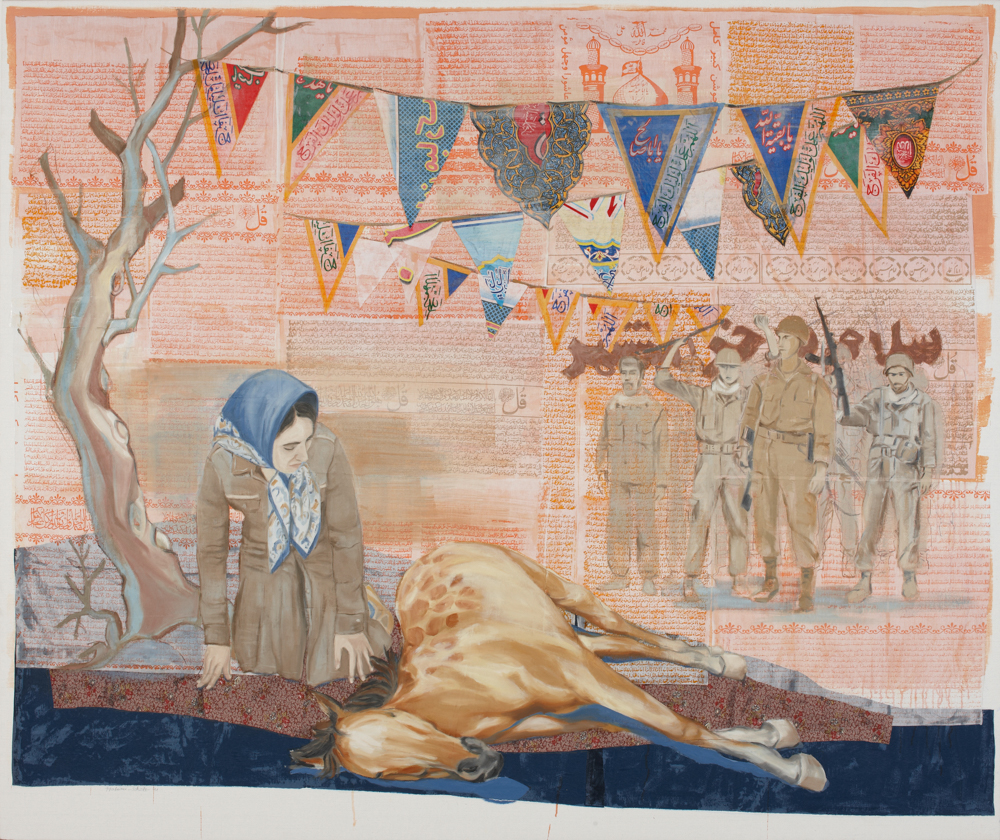
Photo by Michael Klaus, Image courtesy of Mona Hakimi-Schüler
For the works in this particular category, the artist returns to the symbols of Iranian identity such as a lion, sun (whose presence dates back to 500 years ago and was found in Iran’s national flag prior to the Islamic Revolution) and a horse (the animal of transportation of Rostam, the hero in Shahnameh, Iran’s national epic). The display is done with a series of backgrounds that range from the Islamic flag and images to political incidents from the artist’s memories. Looking from a distance as an outsider, we’re not so certain what such superimposition of the old and new identities actually leads to or attempts to criticize. Hakimi-Schüler is currently developing a new approach toward storytelling, which she explains as a nonlinear arrangement of memories where the big picture is created from a collage of bits and pieces of her own recollection.
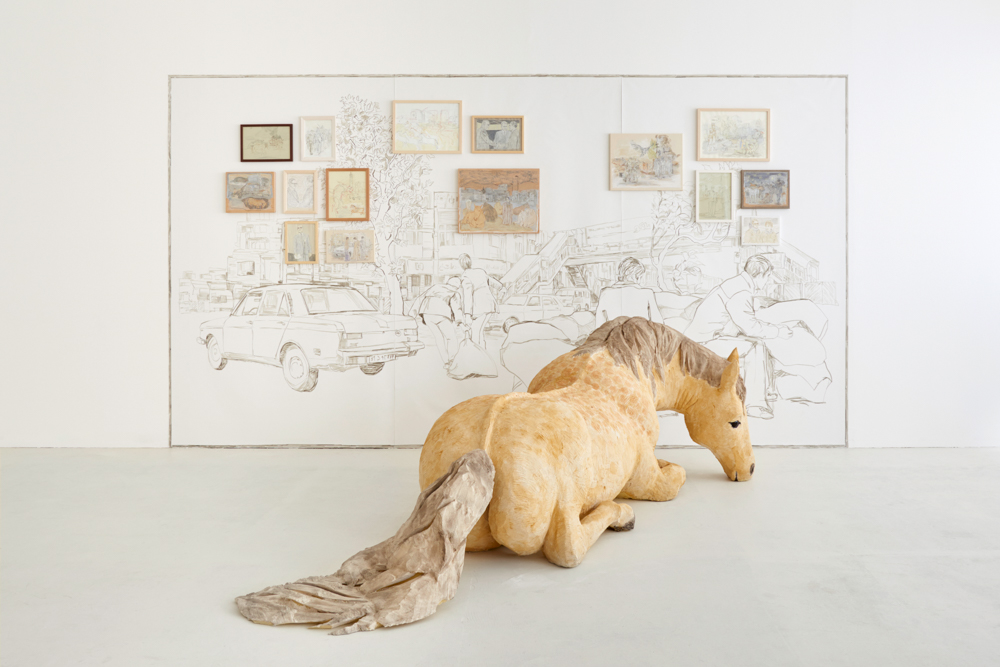
Photo by Michael Klaus, Image courtesy of Mona Hakimi-Schüler
Mona Hakimi-Schüler เกิดในปี 1977 สองปีก่อนหน้าการปฏิวัติอิสลามในอิหร่าน เธอจบการศึกษาด้านวิศวกรรมในระดับปริญญาตรีในเตหะราน ก่อนจะไปศึกษาศิลปะที่เยอรมนี และจบปริญญาโทจาก University of Osnabrück ในปี 2006 ปัจจุบันเธอเป็นศิลปินอิสระอยู่ในเบอร์ลิน แชร์สตูดิโอร่วมกับศิลปินคนอื่นๆ และมีนิทรรศการกลุ่มและเดี่ยวอยู่อย่างต่อเนื่องในรอบหลายปีที่ผ่านมา
Hakimi-Schüler ไม่ได้บอกกับเราว่าทำาไมถึงตัดสินใจย้ายจากอิหร่านไปเยอรมนี แต่ถึงแม้เธอจะใช้ชีวิตทำงานศิลปะในเยอรมนี ผลงานของเธอก็ยังมีกลิ่นอายแบบอิหร่านอยู่อย่างเห็นได้ชัดทั้งในแง่เนื้อหาและสไตล์งาน การใช้ชีวิตวัยเด็กร่วมสมัยกับการปฏิวัติอิสลาม และสงคราม 8 ปีระหว่างอิรัก-อิหร่าน ทำให้เธอเห็นความเปลี่ยนแปลงหลายอย่างในสังคม โดยเฉพาะการเข้าสู่สภาวะสมัยใหม่ของอิหร่าน และความทรงจำในวัยเด็ก ส่วนนี้ก็กลายเป็นวัตถุดิบที่เธอนำมาสร้างผลงานอยู่บ่อยครั้ง Self-portraits (2007) เพ้นท์ติ้งจำนวน 12 ภาพ โชว์ความต่างอย่างสุดขั้วของการแต่งกายแบบต่างๆ ตั้งแต่ห่มคลุมด้วยฮิญาบสีพื้นเรียบๆ ตามประเพณี จับฮิญาบแฟชั่นมาเข้าคู่กับแว่นกันแดดสีชมพู ไปจนถึงเดรสสายเดี่ยว ในงานผลงานชิ้นนี้ ศิลปินพูดถึงการกระเสือกกระสนปรับตัวให้เข้ากับวัฒนธรรมตะวันตกในสังคมอิหร่านโดยใช้เครื่องแต่งกายเป็น medium ในการนำเสนอ สำหรับเธอแล้ว เครื่องแต่งกายที่เปลี่ยนไปไม่ได้เป็นแค่ความเปลี่ยนแปลงของวิชวล ที่ผกผันตามกระแสนิยมเพียงอย่างเดียว แต่เกี่ยวข้องโดยตรงกับอัตลักษณ์และ “บทบาท” ของหญิงผู้สวมใส่ด้วย และกับผลงานนี้หนึ่งในประเด็นสำคัญที่ศิลปินต้องการถามเราก็ คือ “ใน 12 อัตลักษณ์ ที่คุณเห็นข้างหน้านี้น่ะ คิดว่าแบบไหนคือตัวตนจริงๆ ของเราล่ะ?”
ผลงานอินสตอเลชั่นของเธอมีวิธีการจัดแสดงที่น่าสนใจทีเดียว ในผลงานอย่าง Helden-taten (2009-2010) และ Dreaming the past (2012-2013) ศิลปินใช้ผนังห้องนิทรรศการเป็นแบ็คกราวน์ให้กับประติมากรรมที่ถูกติดตั้งในบริเวณใกล้เคียงกัน เพื่อสร้าง scene หรือบริบทมารองรับการปรากฏของตัวละครหลักนั้นๆ ความสัมพันธ์ระหว่างเพ้นท์ติ้งบนฝาผนังกับประติมากรรมนี้เห็นได้ชัดที่สุดในงาน Head in clouds (2014-2015) ที่คนดูอาจจะมองได้สองแบบ คือถ้าไม่ใช่เป็นตัวประติมากรรมเองที่เดินเข้าไปในฉากบนฝาผนัง ก็คงเป็นฝ่ายเพ้นท์ติ้งที่ค่อยๆ งอกออกมาจากระนาบฝาผนัง เป็นประติมากรรมสิงโตที่เดินออกมาหาผู้ชม
ในผลงานกลุ่มนี้ ศิลปินย้อนกลับไปหาอัตลักษณ์เดิมของอิหร่านเมื่อ 500 ปีก่อน ซึ่งก็คือ สิงโตพระอาทิตย์ (สัญลักษณ์นี้เคยปรากฏบนธงชาติอิหร่านก่อนจะถูกถอดออกไปหลังปฏิวัติอิสลาม) และม้า (สัตว์พาหนะของ Rostam ฮีโร่ใน Shahnameh มหากาพย์ประจำาชาติของอิหร่าน) โดยนำกลับมาจัดแสดงคู่กับแบ็คกราวน์หลายๆ แบบ ทั้งธงสัญลักษณ์สำคัญของศาสนาอิสลามหรือภาพเหตุการณ์ทางการเมืองในความทรงจำของศิลปิน ต้องยอมรับว่าการมองจากระยะไกล ทำให้เราไม่แน่ใจว่าการซ้อนกันของอัตลักษณ์เก่า / ใหม่ นั้นนำไปสู่อะไรหรือวิพากษ์อะไรกันแน่ ตอนนี้เธอกำลังพัฒนาวิธีการเล่าเรื่องแบบใหม่ๆ อยู่ เธอบอกว่ามันจะคล้ายๆ กับวิธีการลำดับความทรงจำที่ไม่ได้เรียงเป็นเส้นตรง แต่อาศัยการปะติดปะต่อชิ้นส่วนเข้าด้วยกันเป็นภาพใหญ่
TEXT: NAPAT CHARITBUTRA
PHOTO: MICHAEL KLAU
www.hakimi-schueler.de

